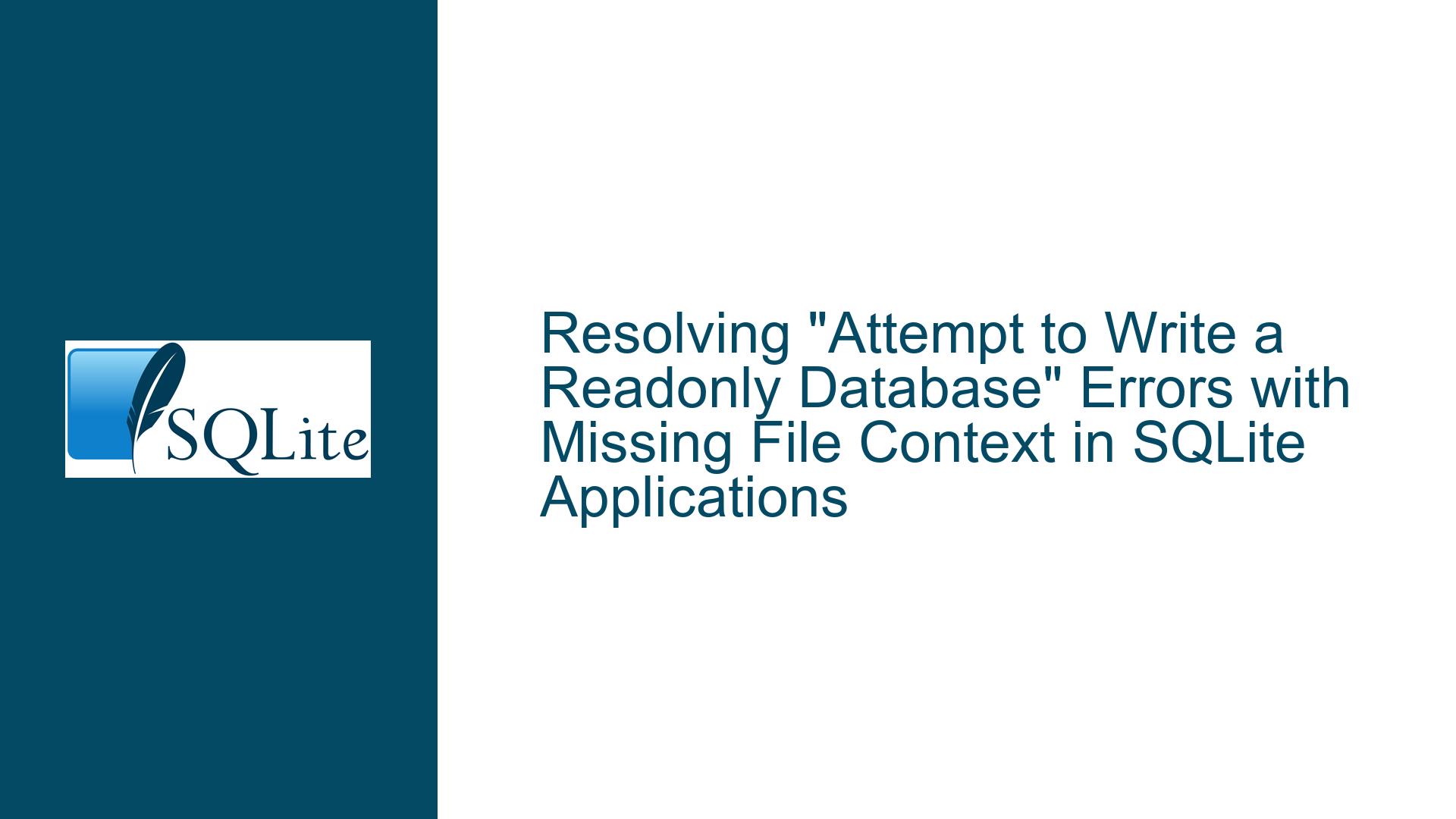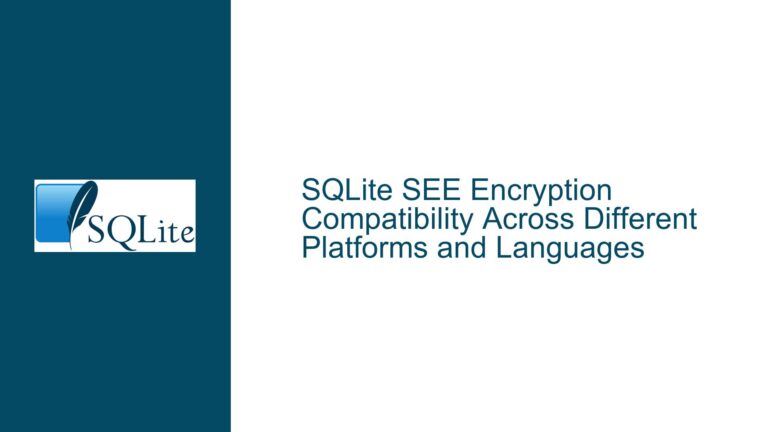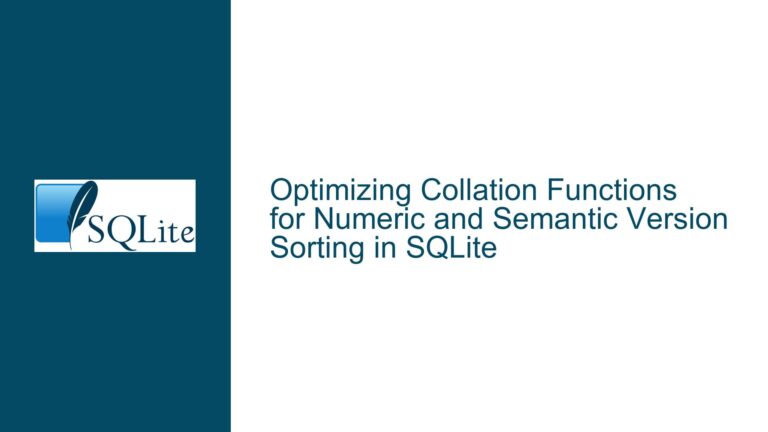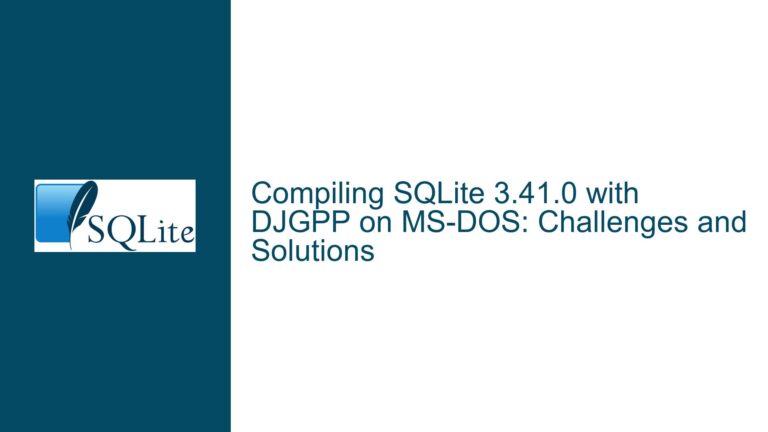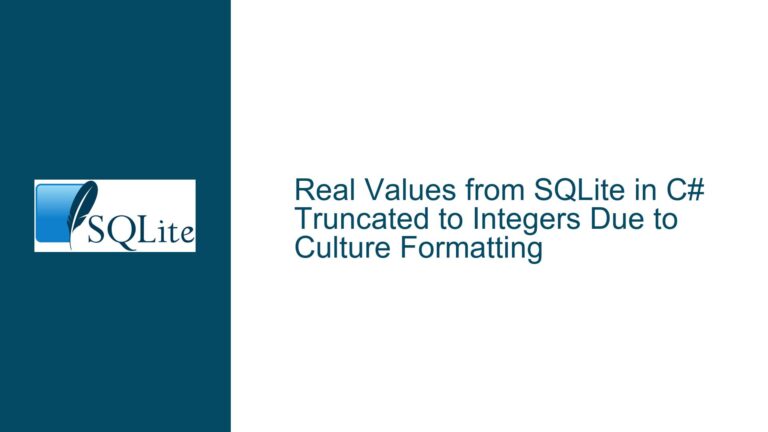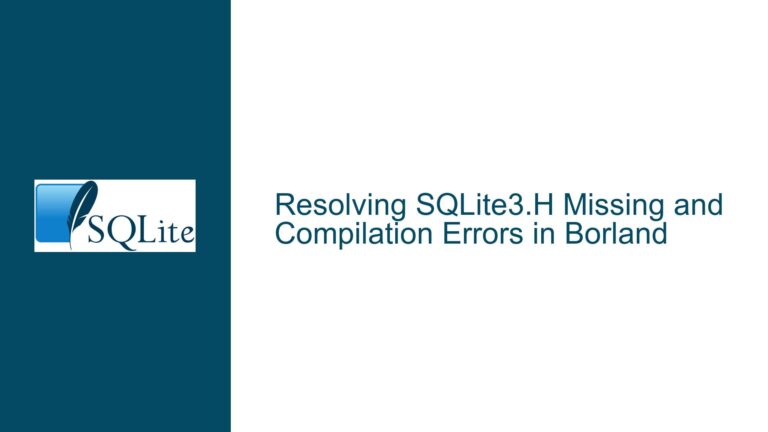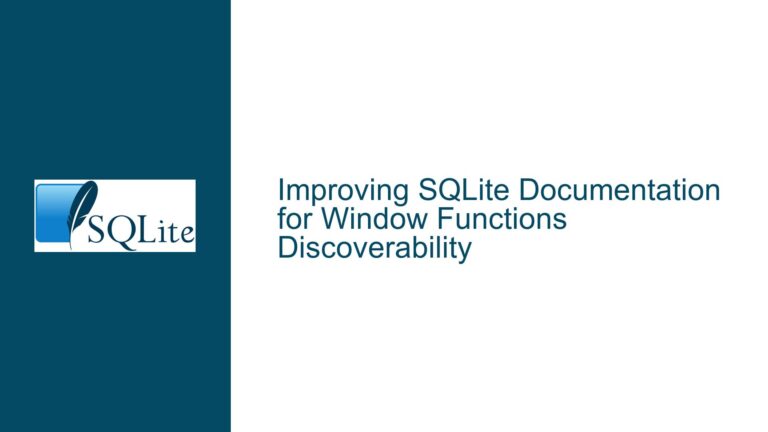Resolving “Attempt to Write a Readonly Database” Errors with Missing File Context in SQLite Applications
Diagnosing and Addressing Ambiguous Database Write Errors in Multi-Connection Scenarios
Root Cause: Ambiguous Error Messages in Multi-Database Workflows
When working with SQLite databases through wrappers like Microsoft.Data.Sqlite, developers often encounter the generic error SQLite Error 8: 'attempt to write a readonly database'. This error arises when an application attempts to modify a database file without sufficient write permissions or when the file is opened in read-only mode. However, the critical issue highlighted in the discussion is the lack of contextual information in the error message—specifically, the absence of the database file path or connection identifier. This omission becomes problematic in applications that interact with multiple databases (e.g., A.db and B.db), as developers cannot immediately determine which database connection triggered the error.
The ambiguity stems from two layers:
- SQLite’s Core Design Philosophy: SQLite’s C library returns error codes and static error messages (e.g.,
SQLITE_READONLY) without including dynamic context like file paths. This is intentional, as the library operates at a low level and does not track metadata such as filenames after a connection is established. - Wrapper Limitations: Higher-level wrappers like Microsoft.Data.Sqlite often propagate these errors verbatim, failing to enrich them with application-specific details (e.g., the connection string or file path used to open the database).
This design creates a gap: developers must correlate error occurrences with the specific database connections involved, which is time-consuming and error-prone in complex applications. For example, if a C# application reads from A.db and writes to B.db, an error during a write operation could originate from either database if permissions are misconfigured or connections are mismanaged. Without explicit file path information in the error message, developers must rely on secondary clues (e.g., stack traces, application logs) to diagnose the issue—a process that adds unnecessary friction.
Why Error Context Is Missing: Technical and Security Constraints
The absence of file paths in SQLite error messages is not an oversight but a deliberate choice influenced by technical limitations and security considerations. Understanding these constraints is crucial for formulating effective workarounds or advocating for upstream changes.
1. Static Error Strings in SQLite’s C Library
SQLite’s core C library prioritizes simplicity and reliability. Error messages like attempt to write a readonly database are static strings defined in the source code (e.g., sqlite3ErrStr[]). These messages do not include dynamic data (e.g., filenames, connection handles) because:
- Memory Safety: Constructing dynamic error strings would require memory allocation, which could fail in resource-constrained environments (e.g., embedded systems). Static strings eliminate this risk.
- Performance: Avoiding string manipulation ensures minimal overhead during error handling, critical for high-performance use cases.
- API Stability: The format of error messages is not part of SQLite’s API guarantees. Applications parsing these messages for automation or logging could break if the format changes.
2. Security Implications of Exposing File Paths
Including file paths in error messages can expose sensitive information about the host system. For example:
- A web application might inadvertently reveal internal directory structures (e.g.,
/var/lib/app/config.db) in error responses sent to clients, aiding attackers in reconnaissance. - Desktop applications logging errors to user-accessible files could leak personal data if database paths include usernames or project names.
While developers can sanitize logs, relying on libraries to avoid exposing such details by default is a safer practice. This aligns with the principle of least privilege: libraries should not assume it’s safe to disclose operational details unless explicitly configured to do so.
3. Wrapper Limitations and Abstraction Gaps
Wrappers like Microsoft.Data.Sqlite abstract low-level SQLite operations but often mirror the C library’s error reporting behavior. When a SqliteException is thrown, the wrapper typically includes the raw error code and message without augmenting it with connection-specific metadata. This happens because:
- Abstraction Layers: The wrapper may not retain context such as the connection string or file path after establishing a connection.
- Backward Compatibility: Changing error message formats could break existing exception-handling logic in applications that parse messages for specific text.
For example, consider a C# application opening two connections:
using var connA = new SqliteConnection("Data Source=A.db");
using var connB = new SqliteConnection("Data Source=B.db");
connA.Open(); // Read-only mode?
connB.Open(); // Read-only mode?
If a write operation fails on one of these connections, the exception will not indicate which connection (connA or connB) caused the error. The developer must manually track this context, which becomes unwieldy in large codebases.
Strategies for Enriching Error Context and Preventing Ambiguity
To resolve the ambiguity in SQLite error messages, developers can adopt a combination of proactive error handling, runtime diagnostics, and library-specific customizations. Below are actionable solutions tailored to different scenarios.
1. Augmenting Error Messages with Connection Metadata
Approach: Intercept SQLite exceptions and enrich them with connection details (e.g., file path, connection mode) before propagating them up the call stack.
Implementation:
- Custom Connection Wrapper: Create a wrapper class for
SqliteConnectionthat tracks the connection string and appends it to exceptions.public class DebuggableSqliteConnection : SqliteConnection { public string ConnectionDetails { get; } public DebuggableSqliteConnection(string connectionString) : base(connectionString) { ConnectionDetails = connectionString; } public override void Open() { try { base.Open(); } catch (SqliteException ex) { throw new SqliteException( $"{ex.Message} (Connection: {ConnectionDetails})", ex.ErrorCode, ex ); } } } - Centralized Exception Handling: Use a global exception handler to log connection-specific details.
AppDomain.CurrentDomain.FirstChanceException += (sender, e) => { if (e.Exception is SqliteException sqlEx) { var connection = sqlEx.Data["Connection"] as string; Logger.Error($"SQLite error on {connection}: {sqlEx.Message}"); } };
Trade-offs:
- Pros: Provides immediate clarity on which database connection caused an error.
- Cons: Requires modifying existing code to use custom connection classes or handlers. May not capture all error sites (e.g., commands executed after opening the connection).
2. Runtime Diagnostics with SQLite Pragmas and Status Checks
Approach: Use SQLite’s built-in pragmas and status queries to gather diagnostic information when errors occur.
Implementation:
- Check Database Writeability: Before performing write operations, verify that the database is writable using
PRAGMA journal_modeor direct file system checks.public static bool IsDatabaseWritable(string filePath) { try { File.OpenWrite(filePath).Close(); return true; } catch { return false; } } - Query Connection Properties: Execute
PRAGMA database_list;to retrieve the list of attached databases and their file paths.public static void LogAttachedDatabases(SqliteConnection conn) { using var cmd = conn.CreateCommand(); cmd.CommandText = "PRAGMA database_list;"; using var reader = cmd.ExecuteReader(); while (reader.Read()) { var name = reader.GetString(0); var file = reader.GetString(1); Logger.Debug($"Attached database: {name} -> {file}"); } }
Trade-offs:
- Pros: No changes required to existing error handling logic. Works with vanilla SQLite wrappers.
- Cons: Adds overhead to each operation. May not catch transient issues (e.g., permissions changing after the connection is opened).
3. File System Permissions and Configuration Audits
Approach: Proactively ensure that database files have correct permissions and are opened in the appropriate mode.
Implementation:
- Explicit Read/Write Mode Specification: Always include the
Mode=ReadWriteparameter in connection strings to force writeable mode.var connStr = "Data Source=B.db;Mode=ReadWrite"; - File System ACL Checks: Validate permissions programmatically during application startup.
public static void ValidateDatabasePermissions(string filePath) { var fileInfo = new FileInfo(filePath); var writeAccess = fileInfo.GetAccessControl() .GetAccessRules(true, true, typeof(NTAccount)) .Cast<FileSystemAccessRule>() .Any(rule => rule.AccessControlType == AccessControlType.Allow && rule.FileSystemRights.HasFlag(FileSystemRights.WriteData)); if (!writeAccess) { throw new UnauthorizedAccessException($"No write access to {filePath}"); } }
Trade-offs:
- Pros: Prevents errors before they occur. Useful for deployment validation.
- Cons: Does not address errors caused by runtime changes (e.g., file permissions being revoked after the application starts).
4. Advocacy for Library-Level Enhancements
Approach: Propose changes to SQLite wrappers (e.g., Microsoft.Data.Sqlite) to include connection metadata in exceptions.
Implementation:
- GitHub Issue/PR Template:
**Proposal**: Enhance SqliteException to include connection details (e.g., Data Source). **Rationale**: When multiple databases are in use, ambiguous errors like "attempt to write a readonly database" delay debugging. Including the file path would resolve this. **Security Note**: Make this opt-in via a connection string parameter (e.g., `IncludeMetadataInErrors=true`). - Prototype Implementation: Fork the library and modify the exception-throwing code to include connection details.
// In Microsoft.Data.Sqlite's SqliteConnection.Open() method: try { base.Open(); } catch (SqliteException ex) { throw new SqliteException( $"SQLite Error {ex.ErrorCode}: '{ex.Message}' (Data Source={ConnectionString})", ex.ErrorCode ); }
Trade-offs:
- Pros: Fixes the issue at the root, benefiting all users of the library.
- Cons: Requires buy-in from library maintainers. May face resistance due to security or compatibility concerns.
Comprehensive Workflow for Debugging Readonly Database Errors
When faced with an attempt to write a readonly database error, follow this structured approach to identify and resolve the issue:
Identify the Offending Connection:
- If using a custom connection wrapper (as described earlier), check the exception message for the connection string.
- If not, cross-reference the stack trace with recent database operations (e.g.,
INSERT/UPDATEstatements) to infer the connection.
Verify File System Permissions:
- On Windows:
icacls "B.db" | findstr "Users" # Ensure "Users" has "RW" permissions. - On Linux/macOS:
ls -l B.db # Ensure the user running the app has write (w) permissions.
- On Windows:
Check Connection Mode:
- Inspect the connection string for
Mode=ReadWrite. If absent, SQLite may open the database in read-only mode if the file is write-protected.
- Inspect the connection string for
Audit Database Locks and Handles:
- Use tools like
lsof(Linux/macOS) orProcess Explorer(Windows) to ensure no other process holds an exclusive lock on the database file.
- Use tools like
Test with In-Memory Databases:
- Temporarily switch to an in-memory database (
Data Source=:memory:) to isolate file system issues. If writes succeed, the problem lies with file permissions or locks.
- Temporarily switch to an in-memory database (
Enable SQLite Tracing:
- Use
sqlite3_trace_v2()or wrapper-specific logging to capture low-level database operations.
// Microsoft.Data.Sqlite example: var connStr = "Data Source=B.db;Password=...;Debug=True";- Use
By systematically applying these steps, developers can demystify ambiguous SQLite errors and implement robust fixes—whether through code changes, configuration adjustments, or advocacy for improved library behavior.
